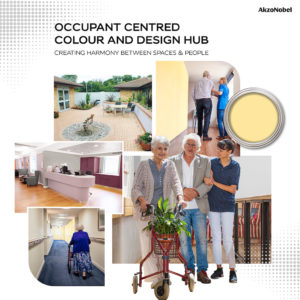Andrew Cleaver, Healthcare Sector Manager at Dulux Trade, explains how colour can be used to support people living with dementia in a home or healthcare environment.
Dementia is a growing challenge across the world. In the UK, the number of people with dementia currently stands at an estimated 850,000 — with someone being diagnosed every three minutes, and one in four diagnosed is currently in an acute hospital ward.
While dementia is a global concern, it’s an issue prevalent in countries where people are likely to live into very old age, including the UK — as it mostly affects people over 65. Therefore, addressing the challenges faced by increasing rates of dementia is high on the agenda for both the NHS and the UK Government.
As vital work gets underway to improve care services, it’s important that design professionals — from architects to decorators — understand how the use of colour and design can help improve living spaces for those diagnosed with the disease. At Dulux Trade, we understand the way people engage with a building can be directly affected by its colour and design, and we strive to ensure professionals have access to best practice colour and design initiatives that promote accessible and inclusive environments — including for people with dementia.
We have this year launched our new Occupant Centred Colour and Design (OCCD) hub, which was set up to provide architects, designers and specifiers with information to create spaces that have a positive impact on the wellbeing of its occupants across a range of sectors, including healthcare and education.

Knowledge hub
The hub has been bolstered with a new specialist section called Designing for Aged Care and Dementia, which sets out how design can be used to create optimal environments for dementia care in both healthcare and residential settings.
It features the Dulux Trade Dementia-Friendly Colour Palette & Design Guide, a set of design principles defined by our colour experts following comprehensive research. The guide incorporates a sympathetic yet contemporary colour palette, as well as offering helpful tips to guide the user. The careful selection of dementia friendly colours for walls, woodwork and doors is supported by advice about patterns and materials that can help those living with dementia to move around their living spaces more easily.
The design hub also includes our Healthcare Design Principles, an evidence-based colour palette, which offers ready-made solutions to help foster better healthcare outcomes in residential homes and hospitals nationwide.
Creating zones
One of the key ways colour can be used is by creating zones and highlighting areas of interest to help people with dementia navigate their home or care setting. Personalising the entrance to a resident’s private living space can further support residents. By introducing a familiar house number, a bedroom nameplate, a piece of art or a display box, a door can be made more recognisable.
Meanwhile, feature walls also help aid wayfinding. Shapes, symbols and landmark objects on walls can help with wayfinding to communal areas that carers may want residents to visit more regularly.
The Dulux Trade Dementia-Friendly Colour Palette includes colours for the main wall scheme, as well as providing plenty of options for feature walls that not only help with wayfinding, but also create a warm and inviting space for visitors and staff alike.
Contrast is really important when designing for people with dementia. Within a care home setting, critical surfaces —such as walls, floors and doors — should be defined and have contrast between them. The recommendation is a minimum of 30 points of Light Reflectance Value (LRV).
For example, in areas where carers may want to discourage access, reducing the contrast between the wall colour and the door colour enables the door to blend into the background, which helps prevent residents from focusing on the door and entering. Other doors where residents are given general access should have sufficient visual contrast (visible standout) to the surrounding walls, to be easily identified by all users.

Other important considerations
While the colour of the space is crucial, it’s not the only important aspect to consider when decorating spaces for people with dementia. All surfaces should be as non-reflective as possible, as gloss produces glare and light bounce, which will hinder residents with visual impairments.
We’d recommend using Dulux Trade Diamond Matt and Eggshell products as they are highly durable, low sheen products which can be used on walls. Meanwhile, Dulux Trade Diamond Satinwood would be the ideal choice for interior doors and trim.
Furnishings are also very important to consider. Professionals should use design to give clear indicators of the use of a room. In a dining room for example, try keeping the table laid with place mats and choosing crockery that contrasts with the table. Or use imagery and symbols on doors, to help reinforce what a room is used for.
Meanwhile, furniture, such as chairs, tables and beds, should contrast against surrounding surfaces to avoid confusion and reduce the potential for trips and bumps. For those with visual impairments, very dark rugs and mats can give the appearance of holes in the floor, and therefore should be avoided.

Dementia demonstration home
As well as offering support to our customers and design professionals, Dulux Trade is committed to long-term initiatives and research to drive forward the design of accessible and inclusive care environments and change the way we think about dementia care.
That’s why, in partnership with BRE, BRE Trust, Loughborough University and Halsall Lloyd Partnership, Dulux Trade has helped build a dementia demonstration home adapted to cater for different types and stages of dementia.
Located within the BRE Innovation Park in Watford, the project — called Chris and Sally’s House — is used to showcase design solutions that support people with dementia living independently in their own homes, with Dulux Trade adding its extensive knowledge about inclusive colour and design to enable both functional and wellbeing occupant outcomes.
We know our work is never done in helping to address the growing challenges of an ageing population. We’re dedicated to doing continuous work to develop innovative solutions that enrich the lives of people with dementia, their families and carers.









